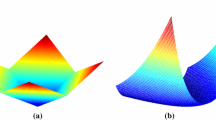Abstract
This paper proposes an escape methodology to the local minima problem of self organizing feature maps generated in the overlapping regions which are equidistant to the corresponding winners. Two new versions of the Self Organizing Feature Map are derived equipped with such a methodology. The first approach introduces an excitation term, which increases the convergence speed and efficiency of the algorithm, while increasing the probability of escaping from local minima. In the second approach, we associate a learning set which specifies the attractive and repulsive field of output neurons. Results indicate that accuracy percentile of the new methods are higher than the original algorithm while they have the ability to escape from local minima.
Similar content being viewed by others
References
Kohonen, T.: Self Organization and Associative Memory (3rd edn), Berlin, Springer Verlag, 1989.
Baykal, N., Reggia, J. A., Yalabik, N., Erkmen, A. and Beksac, S.: Feature discovery and classification of Doppler umbilical artery blood flow velocity waveforms, Comput. Biol. Med. 26(6) (1996), 451–462.
Kohonen, T.: The neural phonetic typewriter, Comput. 21 (1988), 11–22.
Kangas, J. A., Kohonen, T. and Leaksonen, J. T.: Variants of self-organizing maps, IEEE Trans. Neural Networks 1(1) (1990), 93–99.
Nasrabadi, N. M. and Feng, Y.: Vector quantization of images based upon the Kohonen selforganizing maps, In: Proc. IEEE Int.Conf. Neural Network, ICNN-88, San Diego, CA, 1988, pp. 101–108.
Ritter, H. J. and Schulten, K.: Kohonen's self-organizing maps: Exploring their computational capabilities, In: Proc. IEEE Int. Conf. Neural Network, ICNN-88, San Diego, CA, 1988, pp. 109–116.
Ritter, H. J., Martinetz, T. M. and Schulten, K. J.: Topology conserving maps for learning visuo-motor-coordination, Neural Networks 2 (1989), pp. 159–168.
Martinetz, T. M., Ritter, H. J. and Schulten, K. J.: Three-dimensional neural net for learning visuomotor coordination of a robot arm, IEEE Trans. Neural Networks 1(1) (1990), 131–136.
Martinetz, T. and Schulten, K.: Hierarchical neural net for learning control of a robot's arm and gripper, In: Proc. IJCNN-90, San Diego, vol. 3, 1990, pp. 747–752.
Fang, W.-C., Shev, B. J., Chen, O. T.-C. and Choi, J.: A VLSI neural processor for image data compression using self-organization networks, IEEE Trans. Neural Networks 3(3) (1992), 506–518.
Ritter, H. and Schulten, K.: On the stationary state of Kohonen's self-organizing sensory mapping, Biol. Cybern. 54 (1986), 99–106.
Tolat, V.: An analysis of Kohonen's self-organizing maps using a system of energy functions, Biol. Cybern. 64 (1990), 154–164.
Erwin, E., Obermayer, K. and Schulten, K.: Self-organizing maps: Stationary states, metastability, and convergence rate, Biol. Cybern. 67 (1992), 35–45.
Erwin, E., Obermayer, K. and Schulten, K.: Self-organizing maps: Ordering, convergence properties and energy functions, Biol. Cybern. 67 (1992), 47–55.
Lo, Z. P. and Bavarian, B.: On the rate of convergence in topology preserving neural networks, Biol. Cybern. 65 (1991), 55–63.
Lo, Z. P., Yo, Y. and Bavarian, B.: Analysis of the convergence properties of topology preserving neural networks, IEEE Trans. Neural Networks 4(2) (1993), 207–220.
Walter, J. A. and Schulten, K. J.: Implementation of self-organizing neural networks for visuomotor control of an industrial robot, IEEE Trans. Neural Networks 4(1) (1993).
Zheng, Y. and Greenleaf, J. F.: The effect of concave and convex weight adjustments on selforganizing maps, IEEE Trans. Neural networks 7(1) (1996).
Merz, C. J. and Murphy, P. M.: UCI Repository of Machine Learning Databases, http://www.ics.uci.edu/(mlearn/MLRepository.html, Irvine, CA, Univ. of California, Dept. of Information and Computer Science.
Ñneri, M. and Erkmen, A. M.: Erosian of basins of attraction: Performance losses in sensorimotor learning of a robot manipulator, Proc. IEEE Int. Sym. on Intelligent Control, Glasgow, Scotland, U.K., 1992, pp. 77–84.
Devancy, R. L.: Chaotic Dynamical System, Addision-Wesley, 1987.
Haykin, S.: Neural Networks A Comprehensive Foundation, Macmillan College Publishing Company, New York, 1994.
Author information
Authors and Affiliations
Rights and permissions
About this article
Cite this article
Baykal, N., Erkmen, A.M. Extended Self Organizing Feature Map: A Tagged Potential Field Approach. Neural Processing Letters 10, 57–72 (1999). https://doi.org/10.1023/A:1018662813803
Issue Date:
DOI: https://doi.org/10.1023/A:1018662813803




